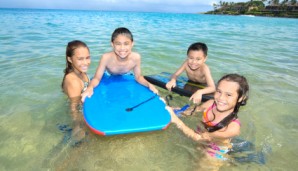
The challenge
The nonprofit Kauai Planning & Action Alliance (KPAA) was established to serve as a catalyst and foster collaboration among government agencies, nonprofits, and community groups on major challenges facing the island. KPAA’s first assignment was to develop indicators and benchmarks to measure progress on issues that were included in the Kauai General Plan 2000.
The challenge was to define the indicators for Kauai with the input of representatives from various island constituencies. The project would require an ongoing commitment by KPAA and the County of Kauai to ensure that the indicators report did not become another dust collector on a shelf.
The process
Kauai Planning & Action Alliance (KPAA) created a case statement that outlined the proposed process with the following elements:
- Project scope and purpose. The scope and purpose of the project was clearly defined, and the project was given a name. The purpose was expanded beyond simply reporting on progress to include indicator measures on important public issues and identification of areas where action was needed.
- Formation of a Community Indicators Advisory Committee. A committee composed of nonprofits, community groups, and state and county agencies from different island locations and sectors was formed to develop and guide the process. The committee was given the authority to define the indicators to be measured. Many of the groups and agencies invited would also provide the data for the resulting report. A draft charter was developed with the intention that it would be ratified by the advisory committee.
- Criteria for indicator selection. Based on the research done during the assessment phase, criteria for selecting indicators were drafted and subsequently confirmed with the advisory committee. The selection criteria were for indicators that:
- Would matter to the community
- Would be relevant to public policy-making
- Would motivate the public to action and engage the media
- Would make use of information that is obtainable
- Would be measurable, understandable, reliable, timely, and capable of showing change over time
- Community input on draft indicators. Once the draft set of indicators was established by the advisory committee, feedback sessions were planned for three geographic areas of the island to solicit feedback on the indicators to determine if these reflected the issues that mattered most to Kauaians.
- A call to action. The report included recommendations for the island’s decision makers that focused on activities they could undertake to ensure that trends moved in a desired direction.
- Frequency of publication. The indicators report would be updated and published biennially.
- Meeting schedule and decision making. A schedule of proposed meeting dates and the decision-making process for the advisory group was established.
- Getting the word out. A draft promotion plan for the published report was created to be ratified by the advisory committee.
This case statement was included with the subsequent invitation to participate in the advisory committee that went out to representatives from a cross section of agencies, organizations, and community groups. At the first meeting, the purpose and background of the indicators project were reviewed, along with the project funding, role of the committee, their commitment, the work plan and schedule, participation guidelines and decision making. Those attending expressed verbal agreement; no formal written agreement was requested.
Over the course of the next few meetings, these categories of indicators were identified:
- Economic and Business Climate
- Public Education
- Neighborhood and Community Well-Being
- Land Use
- Natural Environment
- Civic Engagement
- Cultures and Arts
Seven self-selecting sub-committees were formed to explore indicators for each of these. The initial list of indicators was over 100. Each one was discussed to determine if data could be gathered annually and if it would tell something meaningful about Kauai. The indicators for each category were then prioritized using a system where committee members voted with dots, resulting in a list of 52 indicators.
The next step was to hold three public meetings around the island to talk with community members about the indicators. Three health indicators were added based on suggestions from the public meetings, resulting in a final set of 55 indicators.
The hard work to gather the data began. There was a shocking lack of current, consistently tracked information in many state and county agencies, and a process to secure the data had to be established. Seventeen indicators were translated into questions for a telephone survey. Data was analyzed and a one-page summary was prepared for each indicator. Included in the report was a set of recommendations labeled “Opportunities for Action,” which was intended to (and did) spur action by decision makers.
Lessons learned
- At the outset of this project we sought and received the support of the Mayor, who directed his departments to cooperate with our requests for data. In some cases the departments had to establish a way to gather the data as it wasn’t something they had been doing regularly.
- Since the concept of indicators was new to most folks in the Advisory Committee, we provided them with reports from other communities so they could more clearly see examples and thus understand the purpose and envision what our report might look like.
- There are literally hundreds of indicators that could be used. Narrowing it down to key indicators that reflect the values of the community and would provide meaningful information was a challenge. We had to keep reminding the committee that the best indicators tell more than just the obvious – and when they are combined with others, they can tell a story about our island.
- A sub-committee spent a lot of time reviewing hundreds of sustainability indicators for the natural environment section. In retrospect, it might have been better to present them with a partially screened list of key indicators and allow them to add others back in if needed and develop their recommended set. It was too much to absorb.
- We wanted to ensure that we included indicators that reflected the uniqueness of our island and our state. The rationale for selecting some of our indicators may not be obvious. For example, we track the number of paddlers in canoe clubs. Paddling on a team teaches a number of important Hawaiian values and serves as a way of perpetuating the culture – something important to our island.
- There was strong participation in the early stages where we created and selected indicators. Participation dropped off when we began to analyze selected data – not everyone loves mulling over statistics. We anticipated this in future editions of the report by having a smaller group involved in data analysis but sharing the notes of those meetings with everyone, and bringing everyone back together to review the finished draft.
Tools
